Cassiopeia contains two Messier objects: the open clusters Messier 52 and Messier 103. Both clusters lie in areas with several other notable deep sky objects. They can be easily found using the bright stars of Cassiopeia’s W asterism.
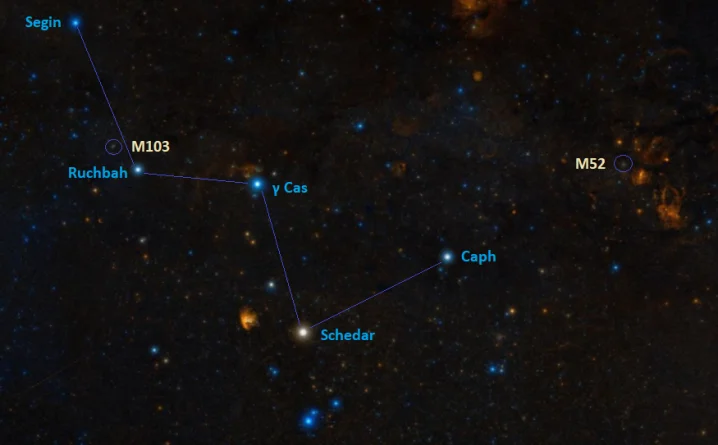
Messier 52 lies along the imaginary line extended from Schedar, the bottom right star of the W, through Caph, the top right star, to the northwest. The distance from Caph to M52 is roughly the same as the distance between Caph and Schedar.
M52 has an apparent magnitude of 6.9 and an apparent size of 13 arcminutes. In good conditions, the cluster can be seen with binoculars. It is easily observed in small telescopes. It lies about 4,600 light years from Earth. Its estimated age is 158.5 million years.
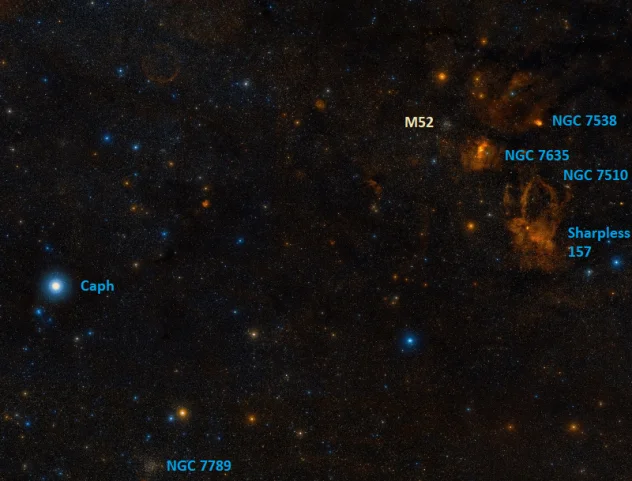
M52 lies in an area dense with deep sky objects. The Bubble Nebula (NGC 7635), a large emission nebula appearing southwest of the cluster, has an apparent size of 15 by 8 arcminutes and lies between 7,100 and 11,000 light years away. It can be seen in 8-inch and larger telescopes.
The nearby star-forming nebula NGC 7538 appears smaller, with an angular size of 9 by 6 arcminutes. It lies in the neighbouring constellation Cepheus. The nebula contains the largest known protostar, which is about 300 times larger than the solar system.
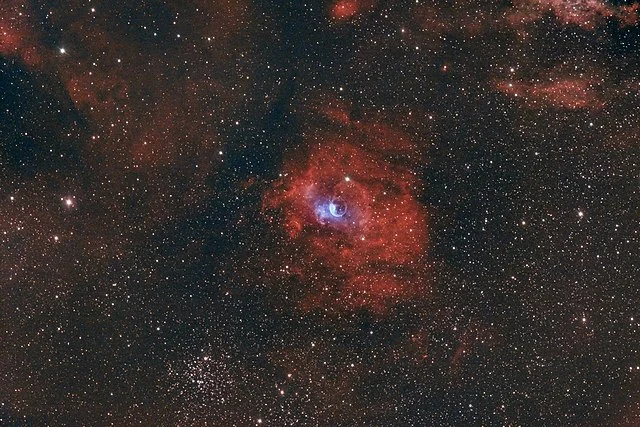
Also located in Cepheus, the open cluster NGC 7510 spans 7 arcminutes of the apparent sky and has an apparent magnitude of 7.9. It lies about 11,400 light years away. Its estimated age is 10 million years.
The Lobster Claw Nebula (Sharpless 157) is a bright star-forming nebula located just south of the Bubble Nebula. The nebula lies about 11,050 light years away. It is ionized by several giant stars, an O-type supergiant, and a young Wolf-Rayet star, WR 157.
Messier 103 lies in the eastern part of Cassiopeia. It can be found a degree east of Ruchbah, the bottom left star of the W, in the region between Ruchbah and Segin, the top left star of the asterism. With an apparent magnitude of 7.4, the cluster is fainter than M52. It also appears smaller, with an apparent size of 6 arcminutes. It lies about 10,000 light years away. Its brightest stars have an apparent magnitude of 10.5 and can be resolved in a small telescope. The cluster is visible in binoculars, but only appears as a hazy patch of light.
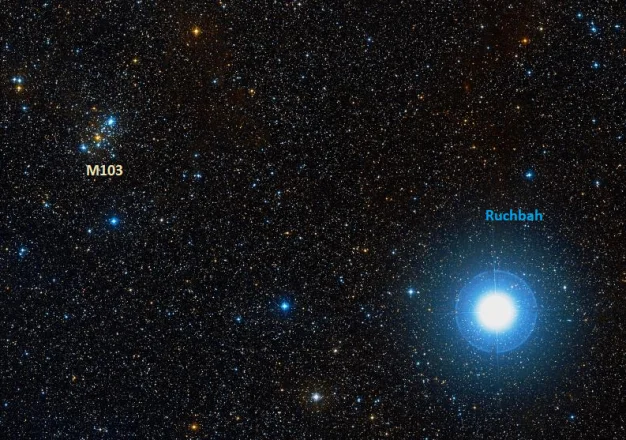
Several other open clusters are located in the same area. IC 166 is relatively faint, with a visual magnitude of 11.7. It occupies 7.5 arcminutes of the apparent sky south of Segin.
NGC 654 appears close to the imaginary line connecting Ruchbah and Segin, 2.5 degrees northeast of Ruchbah. With an apparent magnitude of 6.5, it is easily visible in binoculars. The cluster lies 7,830 light years away and is about 14 million years old. It appears in the same wide field of view as NGC 663 and NGC 659.
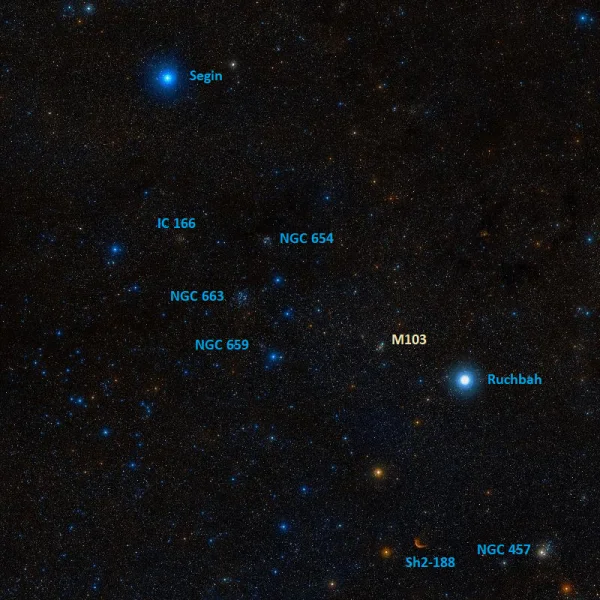
NGC 663 has an apparent magnitude of 7.1 and an apparent size of 16 arcminutes. It is sometimes mistaken for M103. The cluster lies 6,850 light years away. Its estimated age is 20 – 25 million years.
NGC 659 has an apparent magnitude of 7.9 and lies 8,200 light years away. It has an apparent size of 6 arcminutes. The cluster’s estimated age is 20 million years.
Cassiopeia is home to several other bright deep sky objects that were not listed by Charles Messier. These are:
- the Heart and Soul Nebulae (IC 1805 and Westerhout 5), a pair of large neighbouring emission nebulae located 7,500 light years away, appearing east of Cassiopeia’s W
- the E.T. Cluster (NGC 457), an open cluster with an apparent magnitude of 6.4, also known as the Owl Cluster or the Dragonfly Cluster, located southwest of Ruchbah
- the Pacman Nebula (NGC 281), a bright emission nebula 35 arcminutes across, appearing just east of Schedar, the bottom right star of the W
- the magnitude 10.4 irregular galaxy IC 10, the only known starburst galaxy in the Local Group, appearing east of Caph
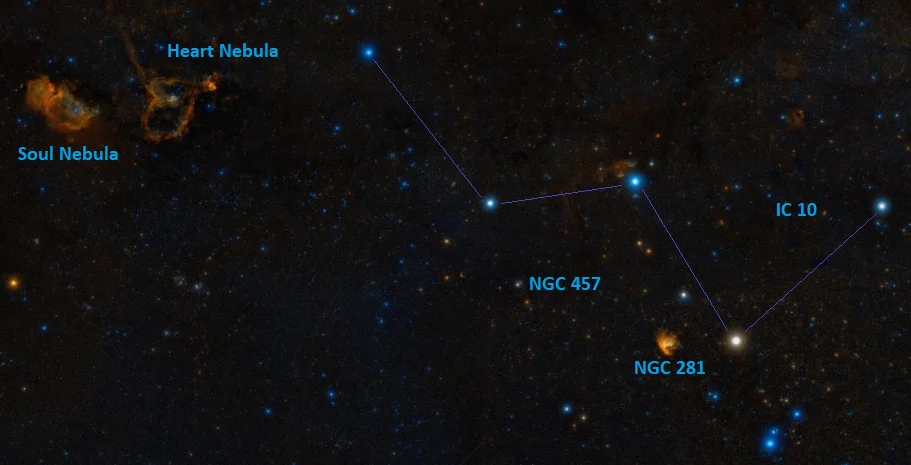
Deep sky objects in Cassiopeia can be seen throughout the year in the northern hemisphere. The best time of year to observe them is during the month of November, when the constellation is high overhead in the evening sky.